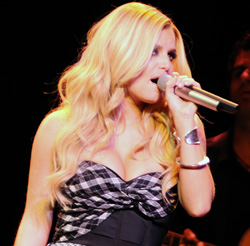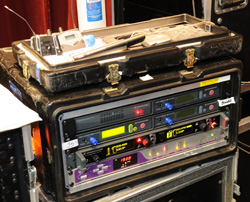
Several of the musicians in the band were using generic ear buds, across a wide range of makes and models, with extremely mixed results.
We replaced them with Future Sonics Atrio Series generic in-ear monitors generously sourced by Hear Technologies. They have a warm, natural sound with extended low-frequency response that’s well suited for younger ears that haven’t been damaged by a decade on a loud stage.
My thanks to Marty Garcia, the godfather of in-ear monitors, for designing these little gems, and for dozens of tips he freely shared with me in my quest to squeeze the highest quality IEM mixes out of our equipment.
Garcia recommends users accustom themselves to new generics by first auditioning them with their iPod in a non-performance situation, such as on the plane, bus or hotel room, and he also recommends output EQ that incorporates a deep notch or high-pass filter at 15,000 Hertz, the upper limit of the frequency response for wireless IEMs, above which a 19,000 Hz pilot tone is used.
Helpful suggestions about the Sennheiser G2 included setting sensitivity at -16 dB to match its gain with the PM5D. He also confirmed that the G2’s HF boost and its internal limiter were not generally helpful.
Also used for my first time was Apogee’s Big Ben outboard digital wordclock. Months previously I followed discussions on ProSoundWeb on the topic of using a Big Ben on Yamaha consoles, and was eager to try one for myself.
Many theatrical productions specify a Big Ben with their Yamaha desks, and I’ve run into many tours and vendors that all had positive comments. I also found Big Bens used on non-Yamaha digital desks. While I’m sure it helped tighten the lows and clean up the highs, especially on transients, the real testimony was when the band all commented on the audio quality after the first night we used it, and I hadn’t told anyone about it.

I’ve asked Apogee if they could produce a compact version similar in form-factor to their old one-third rack-space Mini-Me – maybe call it the Baby Ben or Mini Ben – so one-off engineers can easily carry it in their computer bag or it can be mounted in the dog-house to shorten its cable length. While they’re at it, stereo A-to-D and D-to-A conversion could improve the desk’s money channels. Sort of like a Duet for live sound.
Besides Jessica’s Sennheiser wireless mic and Neumann capsule, we carried almost no microphones, relying for the most part on very standard choices, as our dart-board itinerary of casinos, rodeos, state fairs and television appearances consisted entirely of fly-ins, so the 4U rack and a Pelican were all we carried.
While Shure SM57’s are fine for snare drums, we found them a bit strident on the guitar and steel amplifiers when listened to over IEMs and large format line arrays, preferring the additional fidelity of a large diaphragm condenser on Trey Hill’s Viking guitar amp and Jay Jackson’s Nashville 400.
Though we tried several high end choices, like Nuemann’s TLM 103 and CAD’s Equitek e100, Shure’s KSM 32 provides a very satisfying contoured response and is easily found in the inventory of typical live sound vendors. We also used a second pair as drum overheads.
Backline amps are often left sitting in their case trays which leaves them on wheels, and the slightest nudge, even from a musician adjusting their controls, can cause the amp to move out of place relative to a microphone mounted on a floor stand.
For years I’ve used Z-bars, which help position a mic precisely in front of an amp’s speaker so it can’t move out of place. I have a milk crate full of them in the shop, but they often take a little patience to get the mic positioned correctly. A new device that more easily performs this chore is an Audix spring-loaded “Cab Grabber” mic mount.
The one set of mics we carried were my Audix VX-10 vocal mics that I used for audience reaction. I’ve found that while nearly any cardioid mic can work for applause, it takes extremely natural-sounding microphones to capture the comments and remarks that come from the front section so an artist can properly respond to them, such as “We love you, Jessica!”
Eventually our 2008 itinerary included The Grand Ole Opry, a half-dozen state fairs, five casinos, six television appearances, a pre-NSACAR concert and a post-game “roll-out” for the Diamondbacks. Jessica Simpson is opening for Rascal Flatts in 2009, and I wish her and the band all the best.
Meanwhile I’m waiting for the next surprise phone call. See you all at NAMM. Special thanks to stage manager Walter Earl.
